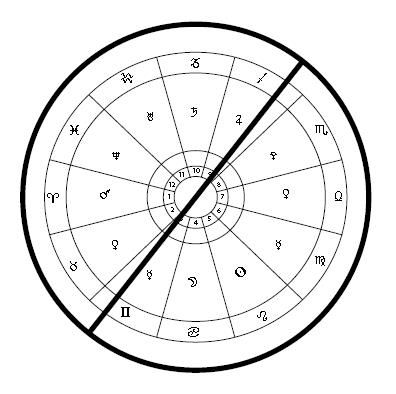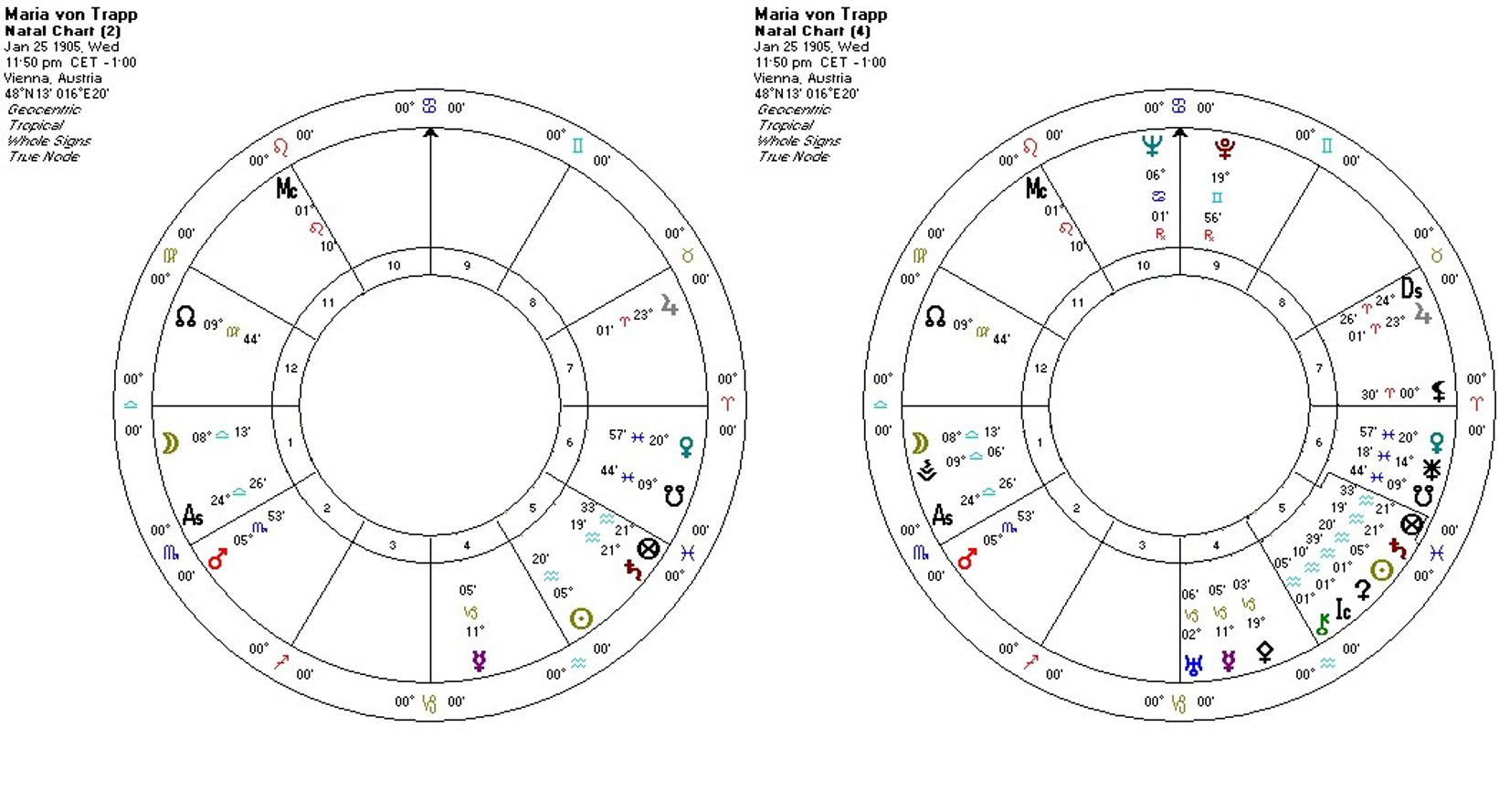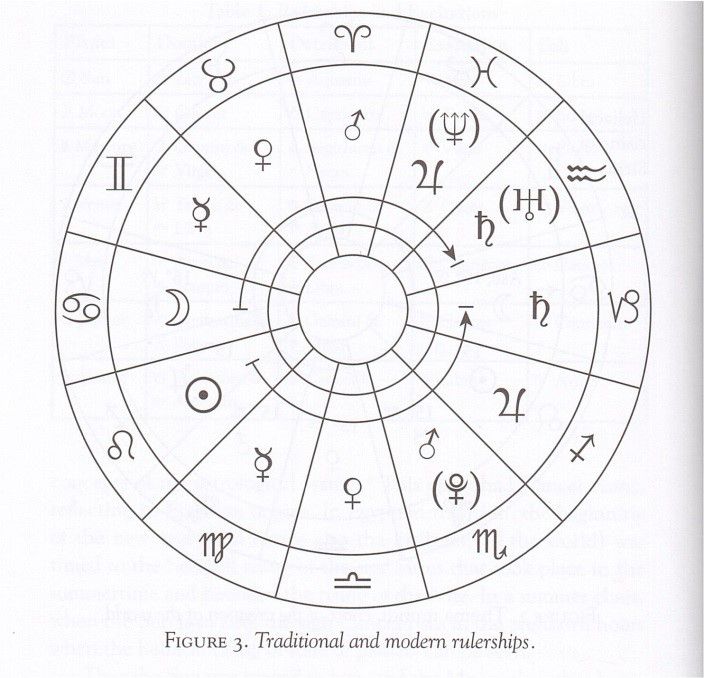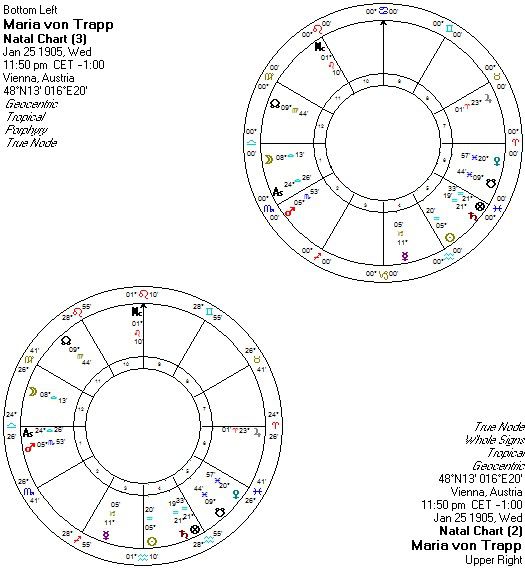現今占星潮流之一是發掘「古老的智慧」。在過去二十年中,有許多可追溯至西元前早期世紀的西方古典占星重要典籍,已從古希臘語、阿拉伯語和拉丁語被翻譯成現代語言出版,這是兩千多年來第一次,占星學界有機會去提供那引導我們當今技巧實踐的希臘化時期、阿拉伯時期、中世紀時期以及文藝復興時期的教導和技術。
從1993年開始,有一小群研究這些典籍的占星學家,他們開始重建這些體系,他們的熱情已經蔓延開來。現在,有越來越多的學生和執業占星師想知道他們究竟在興奮什麼,以及在那些古籍中是否有什麼是對現今時代有價值的。
本文是我即將出版的關於希臘與古典占星實踐手冊中簡介的一部分,本書的目的是指導現代占星師如何透過一步步循序的步驟來朝向運用古代占星學的原則,為詮釋星盤建立更紮實的基礎。
如果你具有現代占星學的背景,那麼在你著手運用古典技法觀察和詮釋星盤之前,有幾個觀念及方法的轉變是必要的。這一開始可能會令人感到不安,因為它會引起你對曾被教導的一些最基本的占星方法產生質疑,但你並不會被要求去否定你已經知道並且發現有價值的東西,只是、在你探索古典技法時,得暫時地將那些觀點擱置一旁,不然,你可能會持續感到困惑、而無法繼續及掌握整個系統。 你可以在學習完成之後再審慎決定你想要如何繼續。
步驟一 暫停使用十二原型系統(The Twelve-Letter Alphabet)
 占星符號系統的基本構成是行星、星座以及宮位,從占星傳統的開端開始,行星已被認為與特定星座及特定宮位具有特殊的對應關係,並且被認為更有利於行星發揮它們的本質。
占星符號系統的基本構成是行星、星座以及宮位,從占星傳統的開端開始,行星已被認為與特定星座及特定宮位具有特殊的對應關係,並且被認為更有利於行星發揮它們的本質。
我們將會在接下來的章節討論這些關聯的細節,這些章節涵蓋了各種黃道十二星座的主星系統和宮位的行星喜樂。
然而,傳統占星學的行星/星座、以及行星/宮位的對應是不同於在20世紀後半所開始普及的現代十二原型系統(或稱十二字母符號系統)。
現代十二原型系統教導一個特定的行星、星座和宮位的意義來自於同一個原則,例如火星、白羊座和第一宮在解釋上是可以互換的, 同樣的邏輯適用於金星、金牛座和第二宮; 水星、雙子座和第三宮; 從傳統的角度來看,雖然火星與白羊座的關聯來自於它是白羊座的主星,但它與第一宮卻沒有任何關聯的基礎,白羊座與第一宮也沒有任何對應的關係,這種操作原理在許多“菜單式占星書籍”中對同一行星、例如火星在雙子座或火星在第三宮,提供相同的解釋是特別明顯而有問題的。 一位古典占星師對於詮釋火星在一個星座或在一個宮位是有完全不同的標準,而不會將雙子座與第三宮視為是相等的。
步驟二 只使用七顆可視的行星
運用占星占卜的證據可追溯至西元前兩千年,當楔形泥板紀錄了七顆看得見的星體 – 太陽,月亮,水星,金星,火星,木星和土星,這些是當時古代人們所唯一知道的星體,一直到17世紀望遠鏡發明之後,天王星,海王星,冥王星和小行星才被發現。因此,古典占星系統可說是橫越4000年,經由巴比倫、希臘、阿拉伯、印度、中世紀和文藝復興時期的占星家們,僅依據這七顆可見的行星所發展淬煉而來的。月亮的北交點和南交點以及許多特殊點(阿拉伯點)也是古典占星符號系統的一部分,但外行星和小行星則不是。
你應該要繼續將這些外行星及小行星納入你的星盤分析(如我所做的),但你將學會以不同於內行星的方式來思考它們,你將學習如何從七個行星中萃取更多關於星盤裡的信息 [圖表 – 2張星盤,一張只有七顆行星; 另一張則包含外行星和小行星]。

步驟三 使用傳統的主星系統
大多數占星家都知道行星主星系統,每個行星被稱為“主管”一個星座; 例如太陽主管獅子座,古代的術語表示每個行星都是一個特定星座的“主人”;並且當它在星盤中恰好位在它所主管星座的位置時,被認為是具有某些力量,古典與現代之間普遍存在的共識,就是太陽守護獅子座,月亮守護巨蟹座,水星是雙子座和處女座的主星,金星是金牛座和天秤座的主星。但是,當現代行星天王星,海王星和冥王星被發現時,古典與現代的系統開始分歧,他們分別被定義為寶瓶座,雙魚座和天蠍座的主星,取代了傳統主星-土星,木星和火星。 古典占星的主星系統,其理論基礎是基於宇宙誕生的象徵性星圖所描述的幾何結構-“Thema Mundi“,而非基於行星和星座之間是否相似的原則。 「宇宙誕生圖( thema mundi )將會在後續黃道星座的章節裡討論。
如下圖所示,當研習古典占星學時,必須使用傳統主星,特別是使用土星作為水瓶座以及摩羯座的主星,木星作為雙魚座及射手座的主星,火星作為天蠍座及白羊座的主星。
這在判斷哪一行星主管哪一個特定宮位,以作為詮釋個人星盤中該宮位的意義時尤為重要。例如,如果有人問到人際關係的主題 – 那由第七宮表示 – 而那宮位是由雙魚座守護,那麼你應該依據木星做出你的判斷、而不是海王星。 [古典與現代主星圖表]

步驟四 使用整宮制
在希臘化時期和阿拉伯時期前700年的天宮圖占星學中,宮位系統的選擇是整宮制,也就是星座與宮位是相合的,每一宮位30度,而且只有一個星座, 這不同於在現代占星學中所使用的象限宮位制,例如普拉希德斯 (Placidus),波菲 (Porphyry),瑞吉歐蒙他拿司 (Regiomontanus) 和科賀(Koch),這些宮位的大小是不均等的,甚至是可以包含一個,兩個或三個不同的星座。古代占星家們注意到、並且討論了其他宮位系統,例如波菲以及等宮制,但是他們謹慎地使用,並且只在有特殊需求的時候。在整宮制的宮位系統中,上升星座的全部度數即為第一宮,所有在那星座的行星,無論位在幾度、都解讀為位在第一宮。 (即使行星是在相同星座的頭3度,而上升在同星座的第28度,那行星仍被解讀為位在第一宮的行星) ;上升點的度數會是第一宮當中的一個點 ,它依然標示著地平線,指著你上升星座的哪個度數是介於地平線以上及地平線以下,它不會將第一宮從第十二宮分出來。而隨著上升星座之後的星座則守護整個第二宮,並且所有在該星座的行星都被視為在第二宮內。
行星的所在宮位位置會在一些星圖保持一樣,但在其他多數的星圖中它們的位置會不同,與象限宮位制做比較的話,有些行星在整宮制中會位在不同的宮位。當重新用整宮制來思考一個人的星盤時,這種不同的觀點可能會對許多占星師造成自我認知混淆的危機,但當你在這整個解讀過程中、你得去反思或去考慮這樣的改變。當你在察看星圖時,可以註記一下哪些行星變換了宮位 [以下為相同星盤在整宮制與波菲宮位制]。

步驟五 行星的狀態
前述四個步驟主要是技術的轉變,但在第五個步驟則需要進行重大的觀念改變。 在現代方法中,星盤中所有的行星被認為是以相等的能力去實現它們所代表的事件,它們只是根據它們星座、宮位和相位的不同方式去實現,詮釋則是將關鍵字的各種組合混合在一起。
然而,在傳統技法中,一些行星比其他行星更能夠為個案以穩定、一致,持久且有益的方式表現其意義,在解讀特定星圖中的行星意涵之前,占星家必須先確認其狀態, 這是基於一些不同條件,例如行星的日夜間區分、主管星座,它與太陽的相位關係及其相位, 這些因素被認為影響了行星為個案帶來正面樂觀成果的能力。古代占星家告訴我們-行星的狀態越好就越能支持行星發揮它的能力,並且它能將工作做得越好。 Vettius Valens在西元二世紀寫道:
位於適當且有利位置的吉星將依據它們的本質以及星座本質,與各個有相位或合相的行星帶來適當的影響, 然而,如果它們位於不佳的位置,反而不利。
同樣的,即使是凶星,當他們在自己的區間內適當運作時,會是最棒的業主,並且象徵偉大的地位與成就;但當它們無力時,會帶來災難和責難。
(維倫斯選集1.1 Riley 譯)
這一段的釋義可以解讀為當吉星在良好狀態時,會依據其所在星座帶來它們特有的意義,但如果它們在不佳的狀態,則反而不利。類似的方式,當凶星在有利條件下時將會帶來良好的結果,偉大的地位和成功; 但狀態不佳時則會帶來災難和責難。
因此,假設一個古典占星家想要解讀火星位於二宮的人的獲取財產以支應生活的能力時,火星會是必須依據日夜間區分進行詳盡分析的首要對象,其次是四種星座統治者狀態(廟、旺、三分性、界),它與太陽的相位關係(速度,能見度,方向,東出/西入)以及從吉星和凶星而來的相位。如果火星狀態良好,那麼占星學家就可以解釋他的財務是穩定與豐碩的。 然而,如果它的狀態被判斷是不好的,那麼解讀時將會採取的思路是-創造收入時的挑戰與矛盾、財務的穩定性以及可能補救的辦法。
請見前段,電影真善美(The Sound of Music.)女主角瑪麗亞·馮·特拉普(Maria von Trapp)的案例星圖。如果一個人詢問財富的問題,古典占星家將開始以下列的方式做出判斷。
二宮代表財富, 它由天蠍座守護、其主星為火星,在此夜間盤中屬於區分內。因為火星位在自己主管的星座,因此它主要暗示對財富有利,因為火星同時主管白羊座七宮,部分財富將來自於婚姻。瑪麗亞是一個孤兒,嫁給了一位富有的男爵,她的丈夫是一位高級軍官(火星)。這是依維倫斯教導的例子,一個狀態良好的火星為瑪麗亞帶來男爵夫人的地位。 請注意,使用冥王星作為天蠍座主星的話不會產生相同清晰的判斷。一個完整的分析還需要考量一些其他的變數,但就目前來說這個簡單示範就足夠了。
本書的第一部將詳細介紹對行星狀態的全面檢視以作為初步的解釋,然後在第二部中探討。你不僅將學習如何判斷一個行星的整體能力對個案而言是強還是弱,也會學習到是哪種特定方式的強或弱。在這個過程中,你將學習古代占星學家如何思考日夜間區分、黃道星座、宮位、相位以及週期。
這其中一些資料會給你許多已被教導的占星原則一個理由,並且為你所學習到任何類型的占星學提供更好的基礎。其他部分的資料可能挑戰你以前思考與解讀的方式,能讓你重新評估或維護你以前的看法。無論如何,你在思考和應用占星的方式將會被刺激和擴大,而且一定會讓你的思考更有深度,同時產生新的方向。
欲知出版詳情,請見demetra-george.com並加入電子報。
(原文請見第二頁)
相關文章閱讀:
行星喜樂:月亮女神的第三宮
美國占星師專訪:Demetra George(迪米特拉‧喬治)
迪米特拉‧喬治-希臘古典占星-線上工作坊
書籍情報:
《占星與真我》
《四女神星》
《四女神星》占星播客專訪
Five First Steps in Traditional Astrology By Demetra George
One of the new waves of contemporary astrology is the discovery of the ‘wisdom of the ancients.’ Over the last two decades, many of the primary source texts for the western astrological tradition, dating to the early centuries CE, have been translated from ancient Greek, Arabic, and Latin. This is the first time in over two thousand years that the astrology community has had the opportunity to purvey the doctrines and techniques of the Hellenistic, Arabic, Medieval, and Renaissance eras that have given rise to our current practice of the art. Starting in 1993 with a small group of astrologers who studied the texts and began to reconstruct the system, their enthusiasm has been contagious. Now more and more students and practitioners are wondering what the excitement is about, and if there is anything in the old texts that may be of value for modern times.
This article is part of the introduction for a forthcoming hands-on workbook book about Hellenistic and Traditional astrology. The book’s aim is to guide the modern astrologer through a step by step process towards utilizing the principles of ancient astrology in order to build a more solid foundation for the interpretation of the natal chart.
If you have a background in modern astrology, there are several conceptual and methodological shifts that are necessary before you can approach the traditional methods of viewing and interpreting charts. This might seem disconcerting at first, as it calls into question some the most basic givens that inform your astrological practice. You are not being asked you to reject what you already know and have found valuable, but simply to temporarily shelve these perspectives as you explore traditional techniques. Otherwise you will most likely encounter ongoing confusion and an inability to proceed and master the system. At the conclusion of your studies you can then make an informed decision as to how you want to continue.
Step One: Suspend Use of the Twelve-Letter Alphabet
The basic components of astrological symbolism are planets, zodiacal signs, and houses. From the beginning of the astrological tradition, planets had special correspondences with certain signs and with certain houses considered more conducive and beneficial to the expression of the planets’ essential natures. We will discuss the specifics of these associations in later chapters that cover various zodiacal-sign rulership systems and the planetary joys of the houses.
However, the planet/sign and planet/house correspondences of traditional astrology differ from the modern twelve letter alphabet system popularized during the second half of the 20th century. The twelve-letter alphabet teaches that the meanings of a particular planet, sign, and house are derived from the same principle, such as Mars, Aries, and the 1st house, and are thus interchangeable in interpretation. The same holds true for Venus, Taurus, and the 2nd house; Mercury Gemini and the 3rd house; etc. From the traditional standpoint, while Mars is associated with Aries as its lord, there is no basis for its association with the first house nor is there any particular correspondence between Aries and the 1st house. This operating principle is especially evident and problematical in the many ‘cookbook style’ interpretation guides that present the same interpretation of a planet – for example Mars –in either Gemini or in the 3rd house. A traditional astrologer would have completely different criteria for the delineating the meaning of Mars in a sign and in a house, and would not equate Gemini with the 3rd house.
Step Two: Use Only the Seven Visible Planets
Evidence for divination by astrology goes back to the second millennium BCE when cuneiform texts identified the seven visible planetary bodies: – Sun, Moon, Mercury, Venus, Mars, Jupiter, and Saturn. These were the only planets known to ancient peoples, as Uranus, Neptune, Pluto, and the asteroids would not be discovered until after the invention of the telescope in the 17th century. Thus the systems of traditional astrology over a 4000 year period, as practiced by Babylonian, Hellenistic, Arabic, Indian, Medieval, and Renaissance astrologers were developed and refined based solely upon these seven visible planets. The North and South Nodes of the Moon as well as Lots (Arabic parts) were also a part of the symbol systems of traditional astrology, but the outer planets and asteroids were not.
You should certainly continue to include the outer planets and the asteroids (as I do) in your chart analysis, but you will learn to regard them in different ways than the inner planets. And you will learn how to extract much more information about the chart from the seven visible planets [Diagram – 2 chart, one with only 7 visible planets; other with outers and asteroids.]
Step Three: Use Traditional Rulerships
Most astrologers are aware of planetary rulerships, whereby each of the planets is said to ‘rule’ a sign; for example the Sun rules Leo. The ancient terminology states that each planet is the ‘lord’ of a particular sign; and when it happens to be located in that sign in a particular chart, it is thought to possess certain powers. There is general agreement between traditional and modern thought that the Sun rules Leo, the Moon rules Cancer, Mercury is the ruler of Gemini and Virgo, and Venus is the ruler of Taurus and Libra. But then the traditional and modern systems begin to diverge. When the modern planets Uranus, Neptune, and Pluto were discovered, they were given as rulers to the signs of Aquarius, Pisces, and Scorpio respectively, displacing the ancient rulers of Saturn, Jupiter, and Mars. The rationale for the traditional system of rulerships was based upon a geometrical substructure depicted by the thema mundi, the symbolic chart of the creation of the world, rather than upon a principle of affinities between planet and sign. The thema mundi will be discussed in the chapter on zodiacal signs.
When practicing traditional astrology, it is necessary to use the traditional rulers of the signs as indicated in the diagram below. In particular use Saturn as a ruler for Aquarius as well as for Capricorn, Jupiter as the ruler of Pisces as well as for Sagittarius, and Mars as the ruler of Scorpio as well as for Aries. This is especially important when determining which planet is the ruler of a particular house in order to interpret the meaning of that house in an individual chart. For example, if someone was to ask about the topic of relationships – signified by the 7th house – and that house is occupied by the sign Pisces, you would look to the planet Jupiter rather than to Neptune to make your judgment. [Circle diagram of rulerships]
Step Four: Use Whole – Sign Houses
For the first 700 years of horoscopic astrology during the Hellenistic and Arabic eras, the house system of choice was whole-sign houses, where signs and houses are coincident. Each house contains all 30 degrees of one – and only one – sign. This differs from the quadrant house systems used in modern astrology, such as Placidus, Porphyry, Regiomontanus, and Koch where houses are of unequal size and can contain a varying amount of degrees of one, two, or even three different signs. Ancient astrologers were aware of and discussed other house systems such as Porphyry and equal houses, but used these sparingly and only for specialized inquires.
In whole sign houses, all of the degrees of the rising sign occupy the first house and all planets in that sign are read as first house planets, regardless of their degree. (Even is a planet is at 3 degrees of a sign and the rising sign is 28 degrees of the same sign, the planet is still read as a 1st house planet). The Ascendant degree is a point floating somewhere in the first house. While it still marks the horizon, designating which degrees of your rising are above the horizon and which are below the horizon, it does not divide the 1st house from the 12th house. The sign following the rising sign occupies the entirety of the 2nd house, and all planets in that sign are considered 2nd house planets, etc.
The house positions of planets will remain the same in some charts, but in most other charts, their house position will differ. Some planets will occupy different houses in a whole-sign house system as compared to a quadrant house system. When reconsidering one’s own chart in whole- sign houses, this different perspective can initially cause an identity crisis for many astrologers; but you are asked to reflect upon and consider the changes as you work through the process. As you look at the example chart, note which planets change house position [Diagram same chart in WS and Porphyry]
Step Five: Planetary Condition
While the first four steps mentioned above are primarily shifts of techniques, this fifth step entails a major conceptual shift. In the modern approach, all of the planets in a particular chart are considered equal in their capacity to bring about their matters; they simply do so in different ways depending upon their sign, house, and aspects. Interpretation involves blending together the various combinations of keywords.
However in the traditional approach, some planets are better able than others to manifest their significations in stable, consistent, long-lasting and beneficial ways for the individual. Prior to interpreting the meaning of a planet in a particular chart, the astrologer must first determine its condition. This was based upon a number of different criteria such as a planet’s sect, zodiacal sign rulerships, its phase relationship to the Sun, and its aspects. These factors were thought to influence the planet’s capacity to bring about positive outcomes for the individual.
Ancient astrologers taught that the better a planet’s condition, the more support a planet has and the better a job it can do. Vettius Valens wrote in the 2nd century:
The benefic stars which are appropriately and favorably situated bring about their proper effects according to their own nature and the nature of their sign, with the aspects and conjunctions of each star being blended. If however they are unfavorably situated, they are indicative of reversals.
In the same way even the malefic stars, when they are operative in appropriate places in their own sect, are bestowers of good and indicative of the greatest positions and success; when they are inoperative, they bring about disasters and accusations. (Anthology1.1 Riley translation)
A paraphrase of this paragraph might read that if the benefic planets are in good condition, they bring about their own significations in accordance with the sign that they occupy, but if in poor condition, they bring about reversals. In a similar way, the malefic planets when in favorable condition bring forth good outcomes, great position, and success; but in poor condition bring about disasters and accusations.
So if a traditional astrologer wanted to interpret how the planet Mars located in the 2nd house might be expected to operate in terms of the person’s ability to generate financial resources to support the livelihood, Mars would first be subject to an exhaustive analysis based upon its sect, four kinds of sign rulerships (domicile, exaltation trigon, bound), its phase relationship to the Sun (speed, visibility, direction, heliacal rise/set), and its aspects from benefic and malefic planets. If the condition of Mars was determined to be good, the astrologer could then build the interpretation upon stable and fortunate money matters. However if the condition was judged to be bad, the reading would take the track of challenges and conflict in generating resources and the stability of finances, as well as possible ways to compensate.
Look at the example chart of Maria von Trapp, heroine of The Sound of Music. If one were to inquire about the topic of wealth, a traditional astrologer would begin to make the judgment in the following manner. The second house signifies money. It is occupied by the sign of Scorpio whose ruler is Mars, which belongs to the sect of this nocturnal chart. Because Mars is located in its own sign of rulership, the primary indication is good for wealth. Since Mars also rules Aries, which is located in the 7th house, part of the wealth comes from the marriage. Maria was an orphan who married a wealthy baron, and her husband was a high ranking military officer (Mars). Here is an example of Valens teaching where a malefic planet Mars in good condition brings about great position for Maria as a baroness. Note that using Pluto as ruler of Scorpio would not yield the same clear determination. A full analysis would factor in a number of other variables, but this simplified version will suffice for now.
Part One of this book will detail a thorough examination of planetary condition as a preliminary to interpretation, which will then be covered in Part Two. You will not only learn how to determine if a planet is strong or weak in its overall ability to do good for the individual, but also in which particular ways is it strong or weak. In the process you will learn how ancient astrologers thought about sect, zodiacal signs, houses, aspects, and phases.
Some of this material will give you the rationale for many astrological doctrines you have been taught as givens and provide a better foundation for any kind of astrology you do. Other parts of this material may challenge your previous ways of thinking and interpretation and put you in a position to reevaluate or defend your former beliefs. In any case, how you think about and practice astrology will be stimulated and expanded, which will inevitably produce a deepening and some sort renaissance.
If you want to be informed as to the publication details, visit www.demetrageorge.com and sign up for her newsletter.

